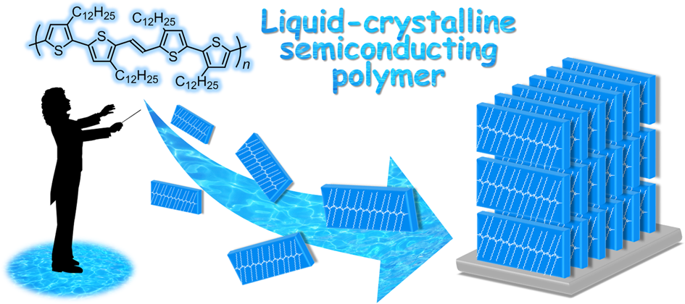Our official English website, www.x-mol.net, welcomes your
feedback! (Note: you will need to create a separate account there.)
A liquid-crystalline semiconducting polymer based on thienylene–vinylene–thienylene: Enhanced hole mobilities by mesomorphic molecular ordering and thermoplastic shape-deformable characteristics
Polymer Journal ( IF 2.3 ) Pub Date : 2019-10-28 , DOI: 10.1038/s41428-019-0282-4 Tatsuya Mori , Hideaki Komiyama , Takahiro Ichikawa , Takuma Yasuda
Polymer Journal ( IF 2.3 ) Pub Date : 2019-10-28 , DOI: 10.1038/s41428-019-0282-4 Tatsuya Mori , Hideaki Komiyama , Takahiro Ichikawa , Takuma Yasuda

|
Liquid-crystalline (LC) π-conjugated polymers are an emerging class of semiconducting materials owing to their promising performance in organic field-effect transistors (OFETs). Little is known, however, about the relationship between LC nature and charge carrier mobility. In this paper, we focus on a thiophene-based p -type semiconducting polymer, PC12TV12T, containing thienylene–vinylene–thienylene (TVT) units, and report a systematic investigation of its thermotropic LC properties, self-organized structures in bulk and thin films, as well as charge transport properties in OFETs. We found that thermal annealing at LC temperatures (99–170 °C) strongly enhanced OFET performance, leading to field-effect hole mobilities as high as 0.37 cm 2 V −1 s −1 , comparable to that of amorphous silicon. By virtue of its thermoplasticity, the TVT-based polymer can also be processed into fine semiconducting microfibers, which can even function as a p -type active channel for charge transport. This bottom-up technology utilizing the LC nature enables cost-effective and energy-efficient manufacture of optoelectronic devices. A π-conjugated polymer based on thienylene–vinylene–thienylene (TVT) units can form a thermotropic liquid-crystalline (LC) mesophase over a wide temperature range. Thermal annealing at LC temperatures strongly enhanced hole mobilities in organic field-effect transistors (OFETs) owing to improved molecular ordering. Because of its thermoplasticity, the TVT-based π-conjugated polymer can also be processed into semiconducting fine microfibers and serve as a charge transport pathway in microfiber OFETs.
中文翻译:

基于噻吩-乙烯-噻吩的液晶半导体聚合物:通过介晶分子排序和热塑性可变形特性增强空穴迁移率
液晶 (LC) π 共轭聚合物是一类新兴的半导体材料,因为它们在有机场效应晶体管 (OFET) 中具有良好的性能。然而,关于 LC 性质和电荷载流子迁移率之间的关系知之甚少。在本文中,我们重点研究了一种基于噻吩的 p 型半导体聚合物 PC12TV12T,它含有噻吩-乙烯-噻吩 (TVT) 单元,并报告了对其热致液晶特性、块状和薄膜中的自组织结构的系统研究,以及 OFET 中的电荷传输特性。我们发现在 LC 温度 (99–170 °C) 下的热退火大大增强了 OFET 性能,导致场效应空穴迁移率高达 0.37 cm 2 V -1 s -1 ,与非晶硅相当。凭借其热塑性,基于 TVT 的聚合物还可以加工成精细的半导体微纤维,它甚至可以用作电荷传输的 ap 型活性通道。这种利用 LC 性质的自下而上的技术可以实现具有成本效益和能源效率的光电器件制造。基于噻吩-乙烯-噻吩 (TVT) 单元的 π 共轭聚合物可以在很宽的温度范围内形成热致液晶 (LC) 中间相。由于改进的分子排序,LC 温度下的热退火大大增强了有机场效应晶体管 (OFET) 中的空穴迁移率。由于其热塑性,基于 TVT 的 π 共轭聚合物还可以加工成半导体微细纤维,并作为微纤维 OFET 中的电荷传输途径。它甚至可以用作电荷传输的 ap 型有源通道。这种利用 LC 性质的自下而上的技术可以实现具有成本效益和能源效率的光电器件制造。基于噻吩-乙烯-噻吩 (TVT) 单元的 π 共轭聚合物可以在很宽的温度范围内形成热致液晶 (LC) 中间相。由于分子排序的改善,LC 温度下的热退火大大增强了有机场效应晶体管 (OFET) 中的空穴迁移率。由于其热塑性,基于 TVT 的 π 共轭聚合物还可以加工成半导体微细纤维,并作为微纤维 OFET 中的电荷传输途径。它甚至可以用作电荷传输的 ap 型有源通道。这种利用 LC 性质的自下而上的技术可以实现具有成本效益和能源效率的光电器件制造。基于噻吩-乙烯-噻吩 (TVT) 单元的 π 共轭聚合物可以在很宽的温度范围内形成热致液晶 (LC) 中间相。由于改进的分子排序,LC 温度下的热退火大大增强了有机场效应晶体管 (OFET) 中的空穴迁移率。由于其热塑性,基于 TVT 的 π 共轭聚合物还可以加工成半导体微细纤维,并作为微纤维 OFET 中的电荷传输途径。这种利用 LC 性质的自下而上的技术可以实现具有成本效益和能源效率的光电器件制造。基于噻吩-乙烯-噻吩 (TVT) 单元的 π 共轭聚合物可以在很宽的温度范围内形成热致液晶 (LC) 中间相。由于改进的分子排序,LC 温度下的热退火大大增强了有机场效应晶体管 (OFET) 中的空穴迁移率。由于其热塑性,基于 TVT 的 π 共轭聚合物还可以加工成半导体微细纤维,并作为微纤维 OFET 中的电荷传输途径。这种利用 LC 性质的自下而上的技术可以实现具有成本效益和能源效率的光电器件制造。基于噻吩-乙烯-噻吩 (TVT) 单元的 π 共轭聚合物可以在很宽的温度范围内形成热致液晶 (LC) 中间相。由于改进的分子排序,LC 温度下的热退火大大增强了有机场效应晶体管 (OFET) 中的空穴迁移率。由于其热塑性,基于 TVT 的 π 共轭聚合物还可以加工成半导体微细纤维,并作为微纤维 OFET 中的电荷传输途径。由于改进的分子排序,LC 温度下的热退火大大增强了有机场效应晶体管 (OFET) 中的空穴迁移率。由于其热塑性,基于 TVT 的 π 共轭聚合物还可以加工成半导体微细纤维,并作为微纤维 OFET 中的电荷传输途径。由于改进的分子排序,LC 温度下的热退火大大增强了有机场效应晶体管 (OFET) 中的空穴迁移率。由于其热塑性,基于 TVT 的 π 共轭聚合物还可以加工成半导体微细纤维,并作为微纤维 OFET 中的电荷传输途径。
更新日期:2019-10-28
中文翻译:

基于噻吩-乙烯-噻吩的液晶半导体聚合物:通过介晶分子排序和热塑性可变形特性增强空穴迁移率
液晶 (LC) π 共轭聚合物是一类新兴的半导体材料,因为它们在有机场效应晶体管 (OFET) 中具有良好的性能。然而,关于 LC 性质和电荷载流子迁移率之间的关系知之甚少。在本文中,我们重点研究了一种基于噻吩的 p 型半导体聚合物 PC12TV12T,它含有噻吩-乙烯-噻吩 (TVT) 单元,并报告了对其热致液晶特性、块状和薄膜中的自组织结构的系统研究,以及 OFET 中的电荷传输特性。我们发现在 LC 温度 (99–170 °C) 下的热退火大大增强了 OFET 性能,导致场效应空穴迁移率高达 0.37 cm 2 V -1 s -1 ,与非晶硅相当。凭借其热塑性,基于 TVT 的聚合物还可以加工成精细的半导体微纤维,它甚至可以用作电荷传输的 ap 型活性通道。这种利用 LC 性质的自下而上的技术可以实现具有成本效益和能源效率的光电器件制造。基于噻吩-乙烯-噻吩 (TVT) 单元的 π 共轭聚合物可以在很宽的温度范围内形成热致液晶 (LC) 中间相。由于改进的分子排序,LC 温度下的热退火大大增强了有机场效应晶体管 (OFET) 中的空穴迁移率。由于其热塑性,基于 TVT 的 π 共轭聚合物还可以加工成半导体微细纤维,并作为微纤维 OFET 中的电荷传输途径。它甚至可以用作电荷传输的 ap 型有源通道。这种利用 LC 性质的自下而上的技术可以实现具有成本效益和能源效率的光电器件制造。基于噻吩-乙烯-噻吩 (TVT) 单元的 π 共轭聚合物可以在很宽的温度范围内形成热致液晶 (LC) 中间相。由于分子排序的改善,LC 温度下的热退火大大增强了有机场效应晶体管 (OFET) 中的空穴迁移率。由于其热塑性,基于 TVT 的 π 共轭聚合物还可以加工成半导体微细纤维,并作为微纤维 OFET 中的电荷传输途径。它甚至可以用作电荷传输的 ap 型有源通道。这种利用 LC 性质的自下而上的技术可以实现具有成本效益和能源效率的光电器件制造。基于噻吩-乙烯-噻吩 (TVT) 单元的 π 共轭聚合物可以在很宽的温度范围内形成热致液晶 (LC) 中间相。由于改进的分子排序,LC 温度下的热退火大大增强了有机场效应晶体管 (OFET) 中的空穴迁移率。由于其热塑性,基于 TVT 的 π 共轭聚合物还可以加工成半导体微细纤维,并作为微纤维 OFET 中的电荷传输途径。这种利用 LC 性质的自下而上的技术可以实现具有成本效益和能源效率的光电器件制造。基于噻吩-乙烯-噻吩 (TVT) 单元的 π 共轭聚合物可以在很宽的温度范围内形成热致液晶 (LC) 中间相。由于改进的分子排序,LC 温度下的热退火大大增强了有机场效应晶体管 (OFET) 中的空穴迁移率。由于其热塑性,基于 TVT 的 π 共轭聚合物还可以加工成半导体微细纤维,并作为微纤维 OFET 中的电荷传输途径。这种利用 LC 性质的自下而上的技术可以实现具有成本效益和能源效率的光电器件制造。基于噻吩-乙烯-噻吩 (TVT) 单元的 π 共轭聚合物可以在很宽的温度范围内形成热致液晶 (LC) 中间相。由于改进的分子排序,LC 温度下的热退火大大增强了有机场效应晶体管 (OFET) 中的空穴迁移率。由于其热塑性,基于 TVT 的 π 共轭聚合物还可以加工成半导体微细纤维,并作为微纤维 OFET 中的电荷传输途径。由于改进的分子排序,LC 温度下的热退火大大增强了有机场效应晶体管 (OFET) 中的空穴迁移率。由于其热塑性,基于 TVT 的 π 共轭聚合物还可以加工成半导体微细纤维,并作为微纤维 OFET 中的电荷传输途径。由于改进的分子排序,LC 温度下的热退火大大增强了有机场效应晶体管 (OFET) 中的空穴迁移率。由于其热塑性,基于 TVT 的 π 共轭聚合物还可以加工成半导体微细纤维,并作为微纤维 OFET 中的电荷传输途径。










































 京公网安备 11010802027423号
京公网安备 11010802027423号